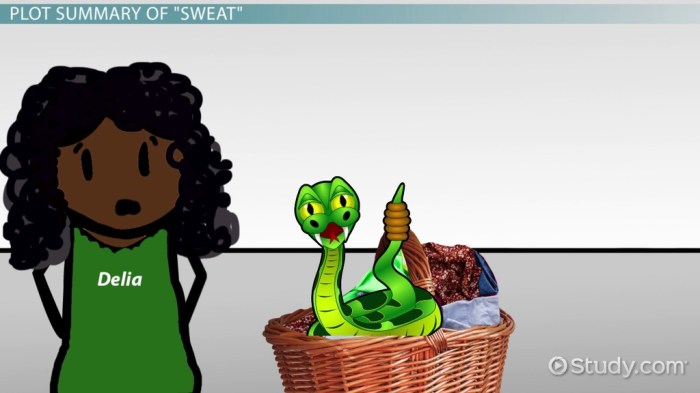Sweat zora neale hurston analysis – Embarking on an in-depth analysis of Zora Neale Hurston’s renowned short story, “Sweat,” this discourse delves into the complexities of gender, nature, and social commentary that are masterfully woven into the narrative. Through a critical examination of the protagonist, Delia Jones, and the multifaceted themes that permeate the story, we unravel the profound insights that Hurston offers on the human condition and the societal structures that shape it.
Sweat by Zora Neale Hurston: Introduction
Set in rural Florida during the early 20th century, “Sweat” by Zora Neale Hurston tells the story of Delia Jones, a hardworking black woman who struggles to maintain her dignity and independence in the face of adversity. The story’s title, “Sweat,” symbolizes the physical and emotional labor that Delia endures as she confronts the challenges of marriage, motherhood, and racial prejudice.
Delia Jones: A Complex Protagonist

Strengths and Weaknesses
Delia is a strong and resilient woman who is determined to overcome the obstacles that life throws her way. She is hardworking, resourceful, and independent. However, she is also proud and stubborn, which sometimes leads her to make poor decisions.
Motivations and Desires
Delia’s primary motivation is to provide a good life for herself and her children. She wants to be independent and self-sufficient, and she is willing to work hard to achieve her goals. She also desires love and respect from her husband, Sykes, but he often disappoints her.
Reflection of Social and Economic Realities
Delia’s experiences reflect the social and economic realities of her time. As a black woman living in the rural South, she faces discrimination and prejudice on a daily basis. She is also struggling to make ends meet, and she is often forced to work long hours in order to support her family.
The Role of Nature and the Environment
Natural Setting and Impact on Characters
The story is set in a rural area of Florida, where the natural environment plays a significant role. The heat and humidity are oppressive, and the characters are constantly sweating. This physical discomfort reflects the emotional turmoil that they are experiencing.
Symbolism of Sweat
Sweat is a powerful symbol in the story. It represents the physical and emotional labor that Delia endures. It also symbolizes the shame and humiliation that she feels as a result of her husband’s actions.
Environment as Support and Challenge
The environment can be both a source of support and a challenge for the characters. The natural beauty of the setting provides a sense of peace and solace, but the harsh conditions can also be overwhelming.
Gender and Power Dynamics

Gender Roles and Expectations
The story explores the traditional gender roles and expectations that are present in Delia’s society. Delia is expected to be a submissive and obedient wife, but she often challenges these expectations. She is strong-willed and independent, and she is not afraid to speak her mind.
Delia’s Challenge to Gender Norms
Delia’s behavior is seen as a threat to the established gender order. Her husband, Sykes, tries to control her, but she refuses to be dominated. She stands up for herself and fights for her rights.
Power Dynamics between Delia and Sykes
The power dynamics between Delia and Sykes are complex. Sykes is the head of the household, but Delia is the one who keeps the family together. She is the one who works hard and provides for her children. Sykes is often abusive and neglectful, but Delia refuses to let him break her spirit.
Symbolism and Imagery
Use of Symbolism and Imagery
Hurston uses symbolism and imagery throughout the story to create a vivid and memorable experience for the reader. The sweat, the churn, and the razor are all symbols that have multiple meanings.
Significance of Objects, Colors, and Sounds
The objects, colors, and sounds in the story are carefully chosen to create a specific atmosphere. The red of the churn represents passion and violence, while the white of Delia’s dress represents purity and innocence.
Contribution to Story’s Meaning
The symbolism and imagery in the story contribute to its overall meaning. They help to create a sense of place and time, and they provide insight into the characters’ thoughts and feelings.
Social Commentary: Sweat Zora Neale Hurston Analysis

Critique of Racism, Sexism, and Poverty, Sweat zora neale hurston analysis
Hurston uses the story to critique the racism, sexism, and poverty that were prevalent in her society. She shows how these forces can destroy individuals and families.
Relevance to Contemporary Society
The story is still relevant to contemporary society. It reminds us that racism, sexism, and poverty are still major problems today. It also shows us the importance of fighting for our rights and standing up for what we believe in.
FAQ Insights
What is the significance of the title “Sweat” in the story?
The title “Sweat” symbolizes the physical and emotional toll that Delia endures throughout the story. It represents the arduous labor she performs to support her family and the emotional turmoil she experiences in her marriage.
How does Delia’s character challenge traditional gender norms?
Delia defies gender expectations by being the primary breadwinner and decision-maker in her household. She is assertive, independent, and unwilling to conform to the passive role typically assigned to women.
What is the role of nature in the story?
Nature is a constant presence in the story, both as a source of sustenance and a symbol of the harsh realities of life. The scorching heat and oppressive environment reflect the challenges that Delia faces.